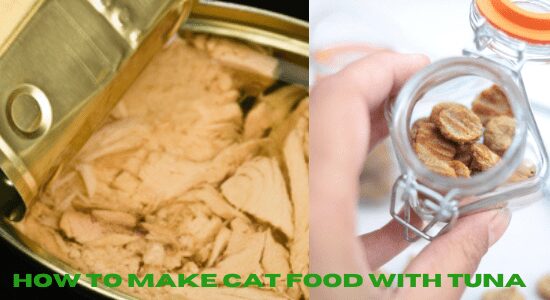How to make cat food with tuna? Cat food with tuna is a great way to ensure that your feline companion gets the needed nutrition. Cats are carnivores, which means they need meat in their diets.
Handling raw fish can be very dangerous for humans since it carries all the bacteria, parasites, and diseases associated with handling poorly cooked foods of animal origin.
The best way to handle cat food with tuna is by making sure that you make the right food choices. Read on to learn more about making cat food with tuna.
Typical cat food with tuna contains just 41% tuna. The rest consists of additives and preservatives to give the food long shelf life and is attractive for cats.
Since fish can be a source of vitamin E, thiamin (B1), niacin (B3), and vitamin B12, it is legal to use fish as the main ingredient of cat food.

Cat food with tuna is not the only brand that contains added vitamins and minerals, but many other brands. In all cases, you should always check the ingredients list on the back of the package to see what’s inside. The amount of added vitamins and minerals is not regulated and varies from brand to brand.
Adding tuna or other fish to cat food also increases the protein content, which is good for your cat. A typical adult cat only needs around 30-35 grams of protein per day (source: FEDIAF ), and since a can of tuna contains about 25 grams of protein, you’re already halfway there when you add half a can of tuna to your cat’s daily food.
Tuna is also rich in fatty acids, but that does not necessarily mean that it is healthy in any way. The reason behind this myth is probably the very low risk of mercury poisoning in tuna compared to other kinds of fish.
Table of Contents
How to make cat food with tuna?
If you want to make cat food with tuna yourself, you need to know that most cats love the taste of tuna. In addition, you also need some other ingredients to create a balanced diet for your cats, such as carbohydrates and vegetables or meat if your cat is not vegan.
In general, it is recommended to check the nutritional information on the label before you buy. The following recipe is intended as a rough guideline since your cat’s nutritional needs may vary from cat to cat based on age, breed, and activity levels.
There are many ways to feed your cat, and one of those ways is by making homemade cat food. This article will teach you how to make tuna-based cat food at home with just a few simple ingredients!
You will need:
- 1 can of tuna (drained)
- 2 cups brown rice, cooked
- 1 cup green peas, cooked and mashed
- ¼ cup carrots, chopped and boiled (optional)
Cook the brown rice and add it to a blender or food processor. Add in all other ingredients and blend well. To serve, add the mixture to a bowl and warm water until it reaches the desired consistency.
Direction:
- Cook the rice and set it aside
- Add all ingredients to a blender or food processor and blend until smooth
- Adjust water for consistency if necessary
Serves:
2.5 cups of cat food (about 5 days for one cat)
Nutritional information per serving:
Calories: 466,
Protein: 30g,
Carbohydrates: 13g,
Fat: 18g
If you want to make a bigger batch or have more than one cat, the recipe can easily be doubled or tripled. Just remember that it is never a good idea to give your human pet food because of the risk of overfeeding and improper nutrition.
Also Read:
How to Make Dry Food for Cat: 3 Easy Steps
Top 5 Easy Steps How to Make Your Own Dry Cat Food
Nutrition Fact Of cat food with tuna
All the necessary nutrients for your cat are found in tuna. This includes vitamin B12, which is an important nutrient for both humans and cats alike. It also provides taurine, another vital nutrient found in meat-based foods that helps prevent certain diseases associated with heart problems.
The Bottom Line
To conclude, giving your cat tuna is not bad at all. It is very healthy for them in moderation, providing lots of protein and other essential nutrients that are great for their well-being. Just be sure never to give tuna when you’re also feeding your dry cat food because the high moisture content would lead to an upset stomach and diarrhea.
We hope that our information has been helpful! If you want to know more about what else goes into making good cat food, let us know in the comments below!

Hi there! My name is Koushik; I am a cat lover. I specialize in writing about pet care & food. I have a wealth of knowledge on cat food niches and related subjects. I have worked in the pet industry for over 5 years and am passionate about helping cat owners provide the best care for their furry friends. With knowledge of cat food and nutrition, I aim to share their insights and help cat owners navigate the world of cat food niches. I enjoy playing with my two cats, reading, and exploring new cat food brands in my free time.
2 thoughts on “How to make cat food with tuna: Perfect Guide You Should Follow”